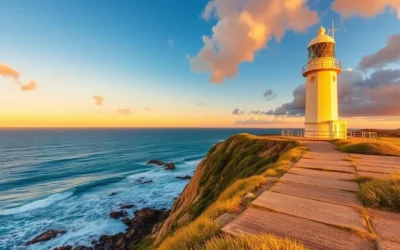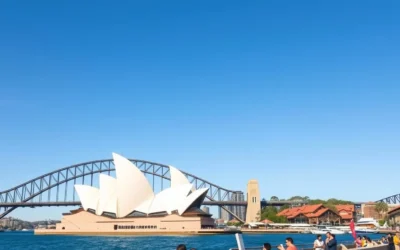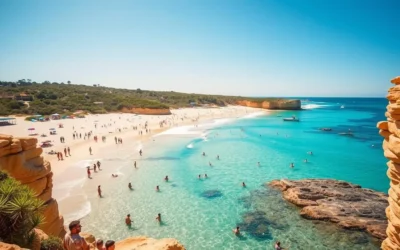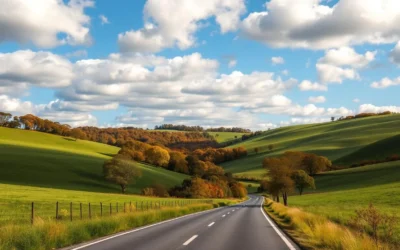Did you know the iconic blue haze that gives the Blue Mountains their name comes from eucalyptus oil droplets released by the vast forests of gum trees? When these microscopic droplets combine with dust particles and water vapor in the air, they scatter short-wavelength rays of light, creating the distinctive blue tint that has enchanted visitors for generations. Just 50 km (31 miles) west of Sydney, this UNESCO World Heritage-listed wonderland spans over 2,679 square kilometers (1,034 square miles) of breathtaking sandstone cliffs, ancient rainforests, and dramatic waterfalls waiting to be explored.
The iconic Three Sisters rock formation overlooking the vast eucalyptus forests of Jamison Valley
Getting There & Planning Your Journey
The Blue Mountains National Park is easily accessible from Sydney, making it perfect for both day trips and extended stays. The foothills begin about 50 km (31 miles) west of Sydney, with the main tourist hub of Katoomba approximately 100 km (62 miles) from the city center.
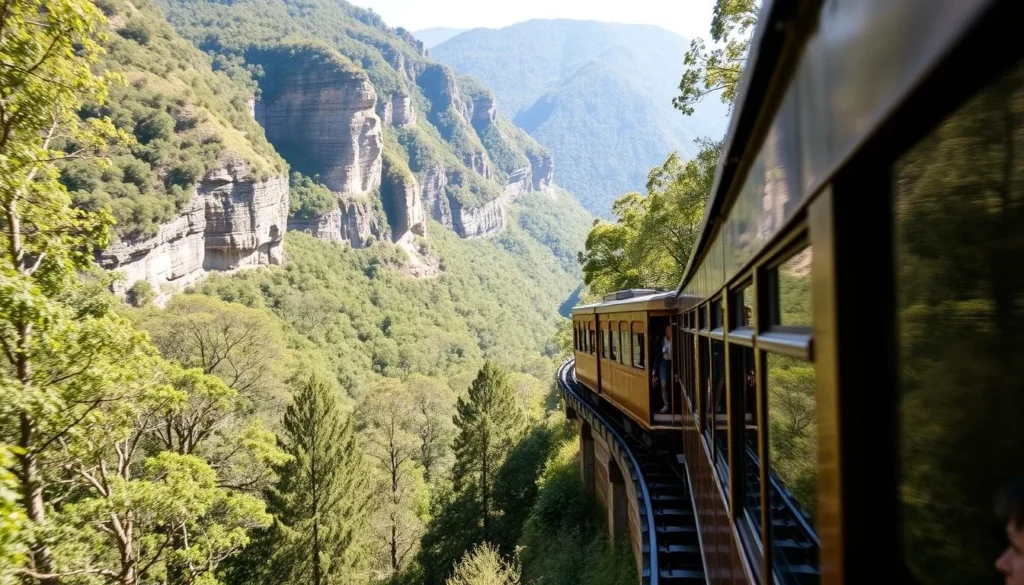
The world’s steepest passenger railway at Scenic World offers a thrilling descent into the Jamison Valley
By Car
Driving to the Blue Mountains takes approximately 90 minutes from Sydney via the M4 Motorway and Great Western Highway. This option offers the most flexibility for exploring different areas of the park. Most major lookouts and attractions have dedicated parking areas, though these can fill quickly during peak periods.
By Train
Regular train services run from Sydney’s Central Station to the Blue Mountains, stopping at major towns including Katoomba, Leura, and Blackheath. The journey takes about 2 hours, and trains typically run hourly. From the train stations, many attractions are accessible by local buses or a short taxi ride.
By Tour
Numerous day tours operate from Sydney, offering convenient transportation and guided experiences. These range from general sightseeing to specialized adventures like bushwalking, abseiling, or cultural tours.
Ready to Plan Your Blue Mountains Adventure?
Start by booking your transportation to this natural wonderland.
Best Time to Visit & Weather Tips
The Blue Mountains experience four distinct seasons, each offering a unique perspective on this magnificent landscape.
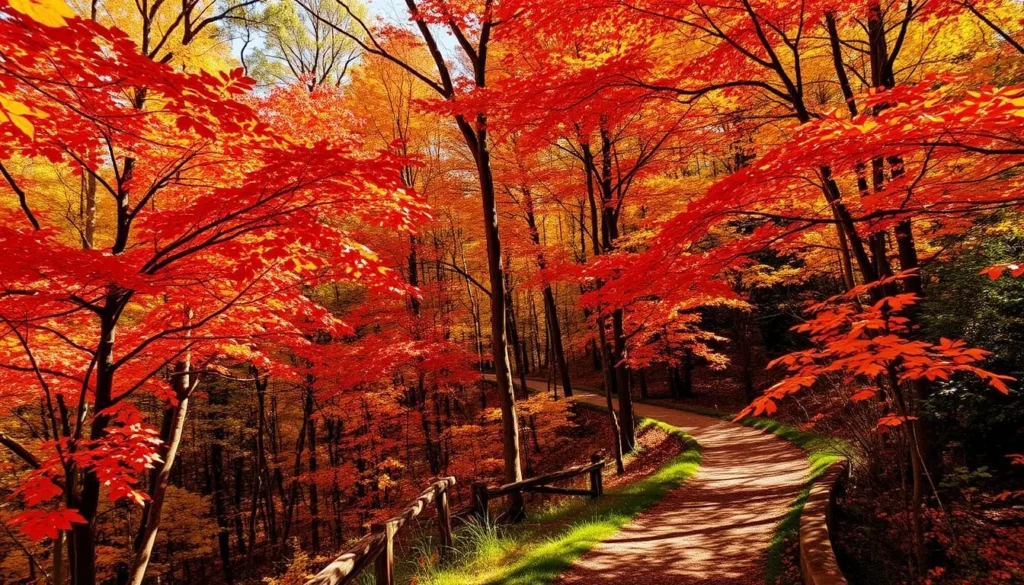
Autumn brings spectacular colors to the Blue Mountains’ gardens and forests
Spring (September-November)
Spring offers mild temperatures ranging from 10-22°C (50-72°F) with blooming wildflowers and gardens. This is an excellent time for bushwalking with comfortable conditions and fewer crowds than summer.
Summer (December-February)
Summer temperatures typically range from 14-29°C (57-84°F), though some days can exceed 35°C (95°F). This is peak tourist season with the longest daylight hours, but also brings higher accommodation prices and more crowded attractions.
Autumn (March-May)
Autumn brings mild temperatures of 9-17°C (48-63°F) with spectacular foliage in the region’s gardens and deciduous trees. The clear, crisp days offer excellent visibility for photography and sightseeing.
Winter (June-August)
Winter temperatures range from 2-10°C (36-50°F) with occasional light snowfall in higher areas. The cooler months offer misty mornings, cozy fireplaces, and significantly fewer tourists, though some activities may be limited.
Weather Tip: Mountain weather can change rapidly. Even in summer, temperatures can drop significantly in the evening, so always pack layers regardless of when you visit. Check for fire danger warnings during summer months.
Getting Around Locally
Once you’ve arrived in the Blue Mountains, you have several options for exploring the region’s many attractions.

The Blue Mountains Explorer Bus provides convenient hop-on/hop-off service to major attractions
Self-Drive
Having your own vehicle offers maximum flexibility for exploring the park’s diverse areas. The main towns and attractions are connected by well-maintained roads, with the Great Western Highway serving as the primary route through the region. Most lookouts and trailheads have dedicated parking areas.
Public Transport
The Blue Mountains Line train connects the major towns, while local buses service popular attractions. In Katoomba and Leura, the Explorer Bus offers a convenient hop-on/hop-off service that stops at 29 attractions, including Echo Point, Scenic World, and various walking trails.
Walking
Many attractions in towns like Katoomba and Leura are within walking distance of each other. The region also boasts an extensive network of walking tracks ranging from easy strolls to challenging multi-day hikes.
Where to Stay
The Blue Mountains region offers accommodation options to suit every preference and budget, from luxury resorts to cozy cottages and budget-friendly hostels.
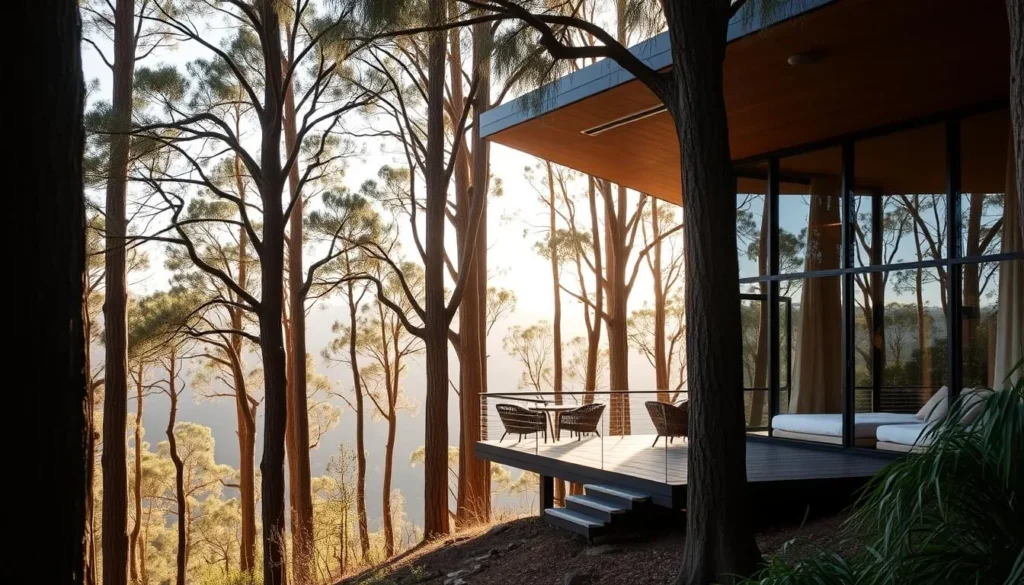
Eco-retreats offer immersive forest experiences with modern comforts
Luxury Options
For those seeking indulgence, the Blue Mountains offers world-class resorts and boutique hotels. Lilianfels Resort & Spa in Katoomba provides 5-star luxury with mountain views, while Emirates One&Only Wolgan Valley offers exclusive villa accommodations with private pools in a conservation reserve.
Mid-Range Accommodations
Numerous bed and breakfasts, guesthouses, and heritage cottages provide comfortable stays with local character. The Carrington Hotel in Katoomba offers historic charm, while self-contained apartments and mountain cabins provide flexibility for families and longer stays.
Budget-Friendly Stays
Backpacker hostels, motels, and campgrounds cater to budget-conscious travelers. The Blue Mountains YHA in Katoomba offers affordable dormitory and private rooms, while national park campgrounds like Blackheath Glen Reserve provide immersive nature experiences.
Find Your Perfect Blue Mountains Accommodation
From luxury resorts to cozy cabins, book your ideal mountain retreat today.
Dining & Local Cuisine
The Blue Mountains region has evolved into a foodie destination, with excellent restaurants, cafés, and food experiences that showcase local produce and international influences.

Local restaurants showcase regional produce with spectacular mountain views
Fine Dining
The region boasts several award-winning restaurants. Darley’s at Lilianfels in Katoomba offers sophisticated modern Australian cuisine in a heritage-listed building, while Echoes Restaurant provides panoramic valley views alongside contemporary dishes influenced by native Australian ingredients.
Casual Eateries
Charming cafés and bistros can be found throughout the mountain towns. Leura Garage, housed in a converted mechanic’s workshop, serves excellent wood-fired pizzas and local wines, while the Gingerbread House in Katoomba offers sweet treats in a restored church building.
Local Specialties
Don’t miss the opportunity to try local specialties like apple pies from the Hominy Bakery in Katoomba, handcrafted chocolates from the Blue Mountains Chocolate Company, or honey from local apiaries. Several microbreweries and boutique wineries also offer tastings of locally produced beverages.
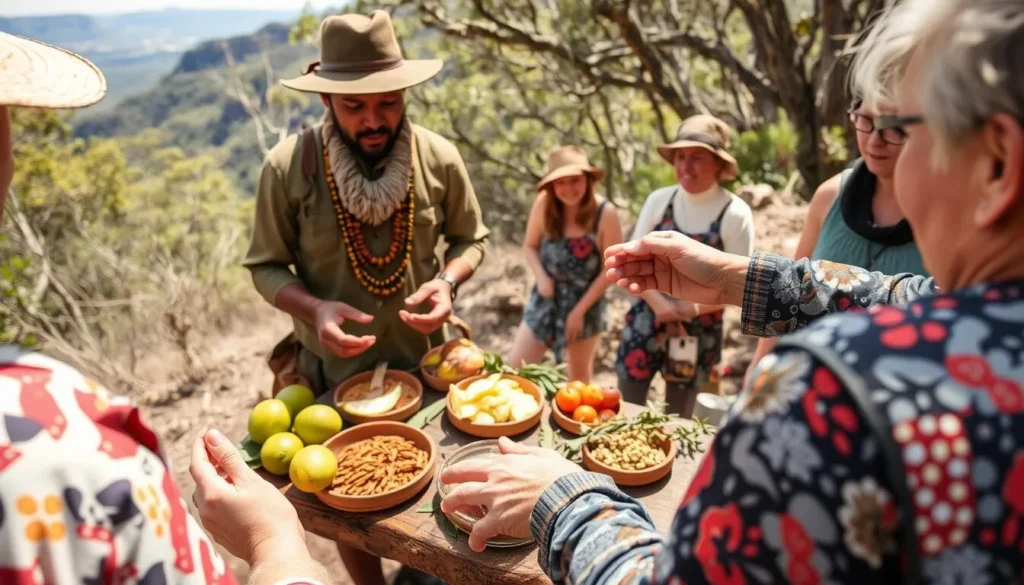
Aboriginal-led bush tucker experiences offer insights into traditional food culture
Top Attractions & Sightseeing
The Blue Mountains National Park is home to some of Australia’s most iconic natural landmarks and attractions.
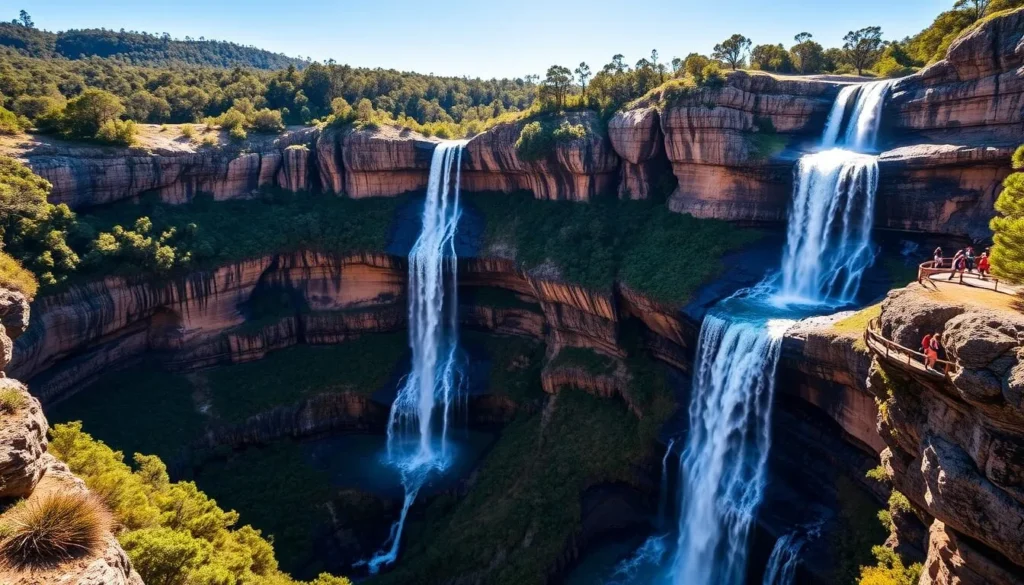
Wentworth Falls drops 187 meters (614 feet) in three spectacular tiers
The Three Sisters
This iconic rock formation at Echo Point in Katoomba is the park’s most famous landmark. The three weathered sandstone pillars stand 922 m (3,025 ft) above sea level, illuminated at night by floodlights. Aboriginal dreamtime stories explain their creation, with one legend telling how a tribal elder turned three sisters to stone to protect them from danger.
Scenic World
Located in Katoomba, Scenic World offers four experiences: the Scenic Railway (the world’s steepest passenger railway with a 52-degree incline), the Scenic Skyway (a glass-bottomed cable car suspended 270 m above the valley), the Scenic Cableway (the steepest aerial cable car in the Southern Hemisphere), and the Scenic Walkway (a 2.4 km elevated boardwalk through ancient rainforest).
Jenolan Caves
Located on the western edge of the Blue Mountains, these limestone caves are among the oldest discovered open caves in the world, dating back 340 million years. Guided tours explore various cave systems with spectacular formations of stalactites, stalagmites, and underground rivers.
Govetts Leap Lookout
This breathtaking lookout near Blackheath offers one of the most spectacular views in the Blue Mountains, with a panoramic vista of the Grose Valley and the 180 m (590 ft) Bridal Veil Falls.
Experience the Best of the Blue Mountains
Book guided tours and activities to make the most of your visit.
Cultural Spots & Aboriginal Heritage
The Blue Mountains hold deep cultural significance, particularly for the six Aboriginal groups who have traditional connections to the land: the Darug, Gundungurra, Wiradjuri, Wanaruah, Darkinjung, and Tharawal peoples.

Red Hands Cave features Aboriginal hand stencils created between 500-1,600 years ago
Aboriginal Cultural Sites
Red Hands Cave near Glenbrook contains well-preserved hand stencils created by Aboriginal people between 500-1,600 years ago. The Lyrebird Dell Walking Track from Leura leads to a sandstone cave used as an Aboriginal shelter for over 12,000 years, while Walls Cave in Blackheath offers another significant cultural site accessible via guided tours.
Waradah Aboriginal Centre
Located in Katoomba, this cultural center offers performances, art exhibitions, and educational experiences that showcase Aboriginal heritage, dance, music, and storytelling. Visitors can learn about traditional tools, weapons, and cultural practices from knowledgeable guides.
Blue Mountains Cultural Centre
This modern facility in Katoomba houses the Blue Mountains City Art Gallery and World Heritage Exhibition, providing insights into the natural and cultural significance of the region through interactive displays, artwork, and educational programs.
Norman Lindsay Gallery
The former home of controversial Australian artist Norman Lindsay in Faulconbridge is now a gallery showcasing his paintings, sculptures, and illustrations. The sandstone cottage and beautiful gardens offer a glimpse into the life of one of Australia’s most famous artists.
Outdoor Adventures & Activities
The Blue Mountains National Park is a paradise for outdoor enthusiasts, with activities ranging from gentle nature walks to adrenaline-pumping adventures.
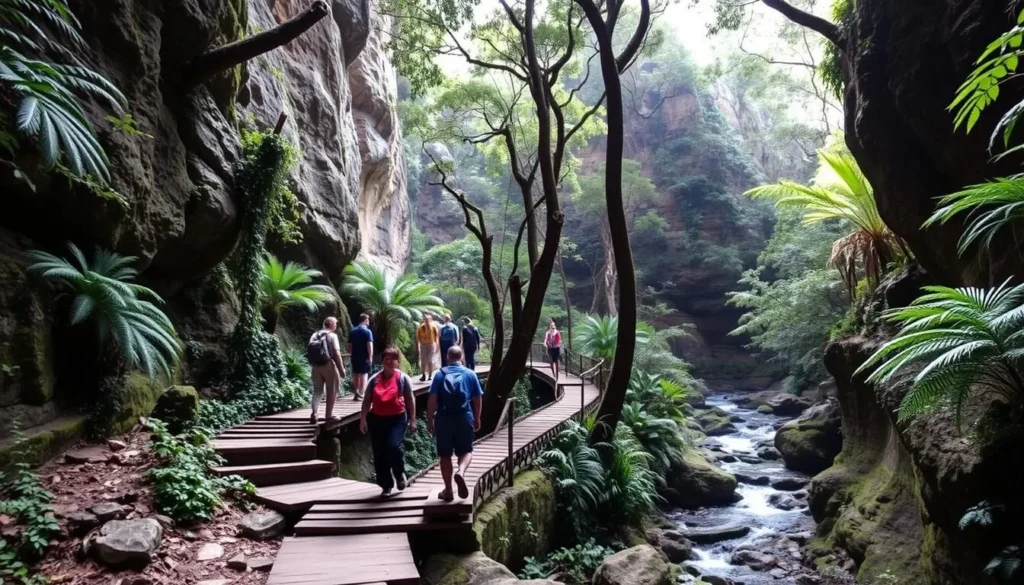
The Grand Canyon Walking Track offers a 6.3 km (3.9 mi) loop through stunning rainforest
Bushwalking
With over 140 km (87 mi) of walking tracks, the Blue Mountains cater to all fitness levels. Popular trails include:
- Grand Canyon Track (6.3 km/3.9 mi loop): A moderate walk through lush rainforest with waterfalls and sandstone cliffs
- Three Sisters Walk (1 km/0.6 mi return): An easy paved walk to the iconic formation
- National Pass (5 km/3.1 mi loop): A challenging trail with spectacular waterfall views
- Cliff Top Walking Track (3 km/1.9 mi one-way): A moderate walk between Govetts Leap and Evans Lookout
Adventure Activities
For thrill-seekers, the Blue Mountains offer numerous adventure opportunities:
- Rock climbing and abseiling on the sandstone cliffs
- Canyoning through narrow slot canyons and waterfalls
- Mountain biking on dedicated trails
- Horseback riding through valleys and forests
Wildlife Spotting
The park is home to diverse wildlife including kangaroos, wallabies, echidnas, and over 400 bird species. Dawn and dusk offer the best opportunities for wildlife viewing, particularly in less visited areas of the park. The Glow Worm Tunnel near Lithgow provides a magical experience of bioluminescent larvae illuminating an abandoned railway tunnel.

Guided abseiling experiences offer thrilling descents of sandstone cliffs up to 30 m (98 ft) high
Safety, Etiquette & Practical Tips
While the Blue Mountains offer incredible experiences, proper preparation and awareness are essential for a safe and enjoyable visit.

Trail information boards provide essential safety details and difficulty ratings
Bushwalking Safety
When hiking in the Blue Mountains:
- Stay on marked trails and behind safety barriers at lookouts
- Carry plenty of water, snacks, first aid supplies, and a fully charged phone
- Check weather forecasts and park alerts before setting out
- Register your trip intentions for longer walks at the Blue Mountains Heritage Centre in Blackheath
- Wear appropriate footwear and sun protection
Fire Safety
Bushfires are a serious risk, particularly in summer:
- Check fire danger ratings and park closures during fire season (October-March)
- Comply with all fire bans and restrictions
- Report any unattended fires to emergency services (call 000)
Wildlife Etiquette
Respect the natural inhabitants of the park:
- Observe wildlife from a distance and never feed native animals
- Take all rubbish with you when leaving
- Stay on designated paths to minimize environmental impact
- Be aware of snakes during warmer months – if encountered, remain still until they move away
Important: Mobile phone coverage can be limited or non-existent in valleys and remote areas of the park. Download offline maps and inform someone of your plans before heading into isolated areas.
Ready for Your Blue Mountains Adventure?
The Blue Mountains National Park offers a perfect blend of natural wonders, cultural experiences, and outdoor adventures just a short journey from Sydney. From standing in awe before the Three Sisters to discovering hidden waterfalls and ancient Aboriginal sites, this UNESCO World Heritage area provides unforgettable experiences for every type of traveler.
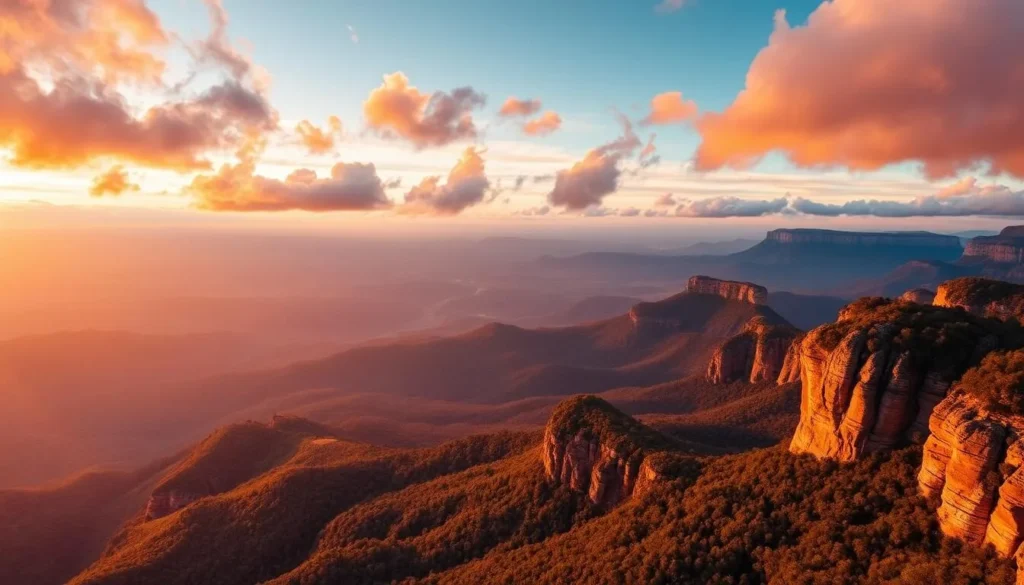
Sunset transforms the Blue Mountains with golden light and deepens the mysterious blue haze
Whether you’re seeking adventure, relaxation, cultural insights, or simply the chance to reconnect with nature, the Blue Mountains provide the perfect backdrop. With its accessibility from Sydney, diverse accommodation options, and year-round appeal, it’s no wonder this magnificent landscape has captivated visitors for generations. Pack your hiking boots, charge your camera, and prepare to be amazed by one of Australia’s most spectacular natural treasures.
Start Planning Your Blue Mountains Escape Today
Book your transportation, accommodation, and activities for an unforgettable mountain adventure.
The above is subject to change.
Check back often to TRAVEL.COM for the latest travel tips and deals.

